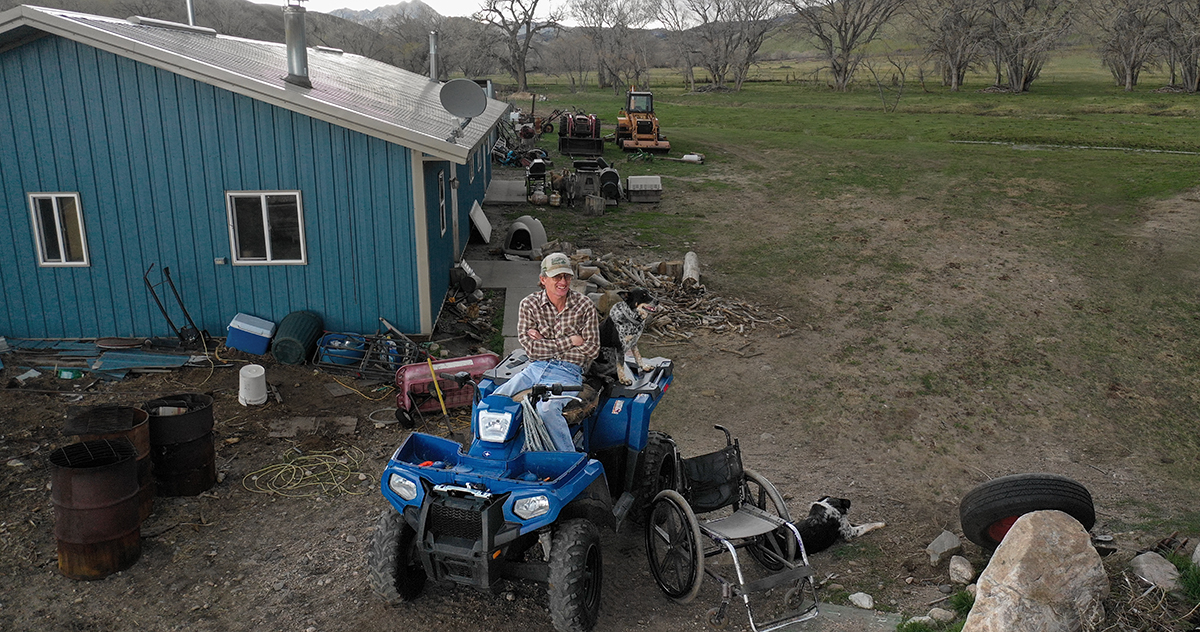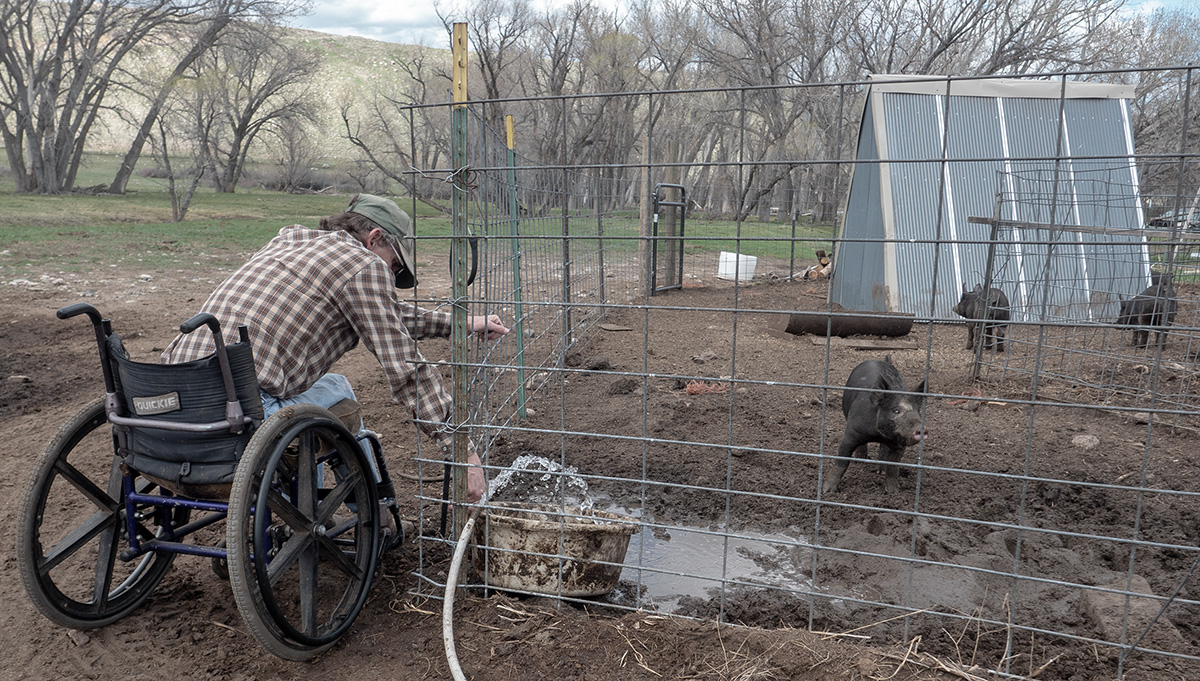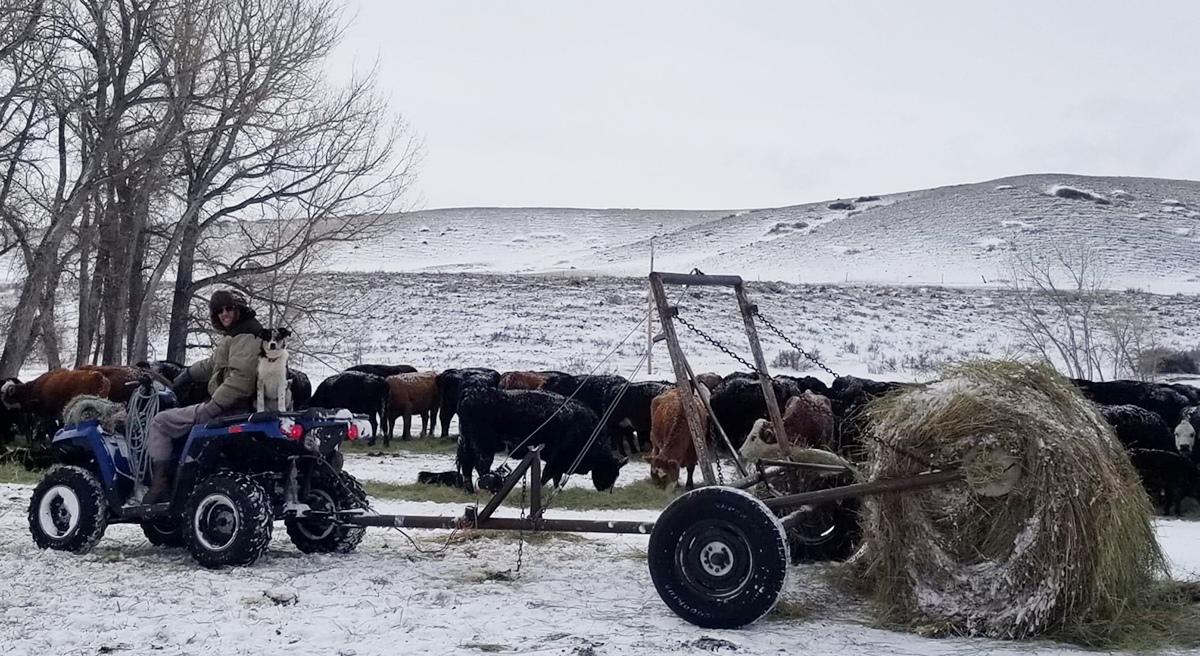‘I Am the Rancher in Wyoming You Are Trying to Reach’
A correspondence between rancher Henry Poling and farmer Tim Gilmer, winter through spring.
Photos by Kirk Williams
.
Dear Mr. Gilmer,
I am the rancher in Wyoming you are trying to reach — Henry Poling. My dear friend Dave Foreman forwarded an email to me that you sent him in regard to getting ahold of me for a story in NEW MOBILITY magazine. I ranch west of Wheatland, Wyoming, out of a wheelchair. If you would like you can email me or call me on the phone — it is a land line and not text capable. Thank you.
Tim Gilmer: Henry, I would love to get acquainted. I feel we are kindred souls. I am a farmer-writer, paraplegic since 1965, semi-retired after editing NEW MOBILITY for 18 years. My wife and I and a small crew of workers grew organic veggies on our farm and sold them to restaurants and markets in Portland for about 30 years. We also had a small herd of cattle for 20 of those years. I think our readers would benefit greatly from getting a glimpse of your lifestyle — and your connection with land, livestock and people.
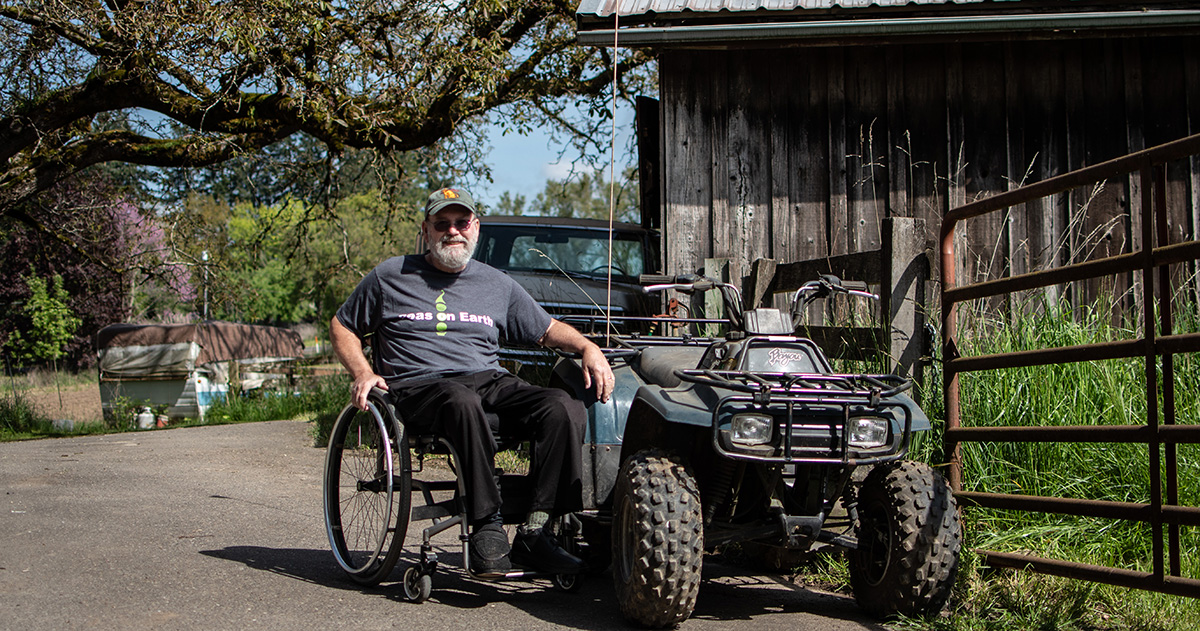 In a unique email relationship, Tim Gilmer (above) and Henry Poling, fellow paraplegics, discovered they are kindred souls who love the land, cattle ranching and farming — and what it means to persevere through difficult times. Tim’s photo by Jackson Pickard.
In a unique email relationship, Tim Gilmer (above) and Henry Poling, fellow paraplegics, discovered they are kindred souls who love the land, cattle ranching and farming — and what it means to persevere through difficult times. Tim’s photo by Jackson Pickard.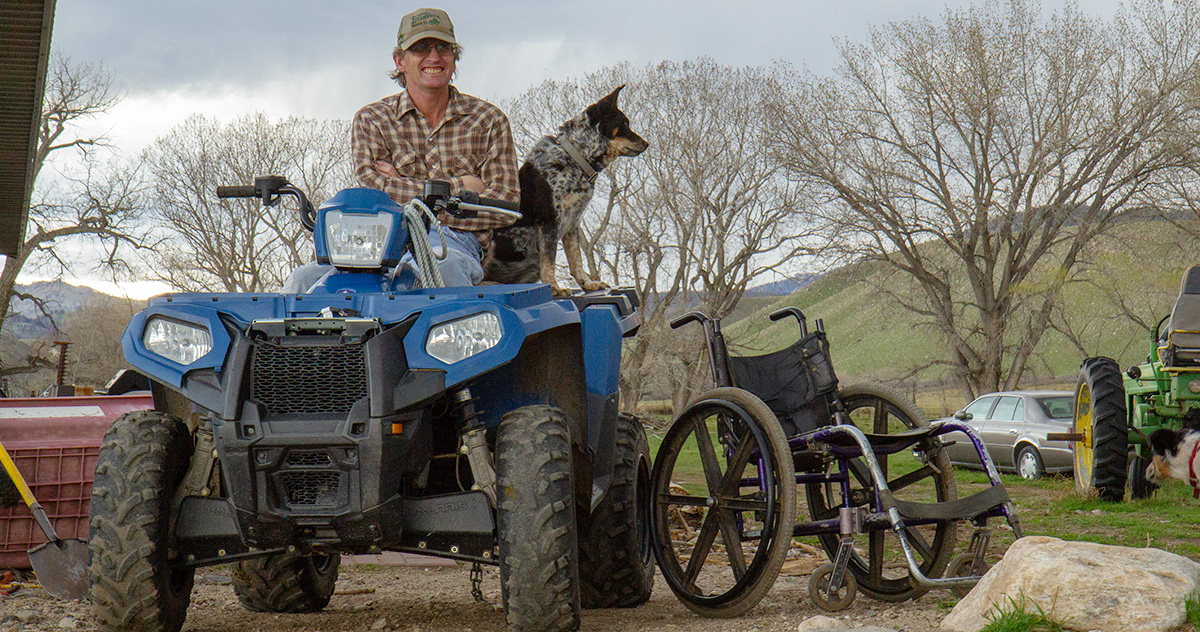
HP: Good Morning, Tim. It is clear and cold here in Wyoming with a northeast breeze. My cows are getting close to calving, should start in a couple weeks. I have a little over 100 head of mother cows to calve. I normally try to run about 150 but had a bad drought that made me sell off a lot, and build-back has been slow.
As I tell everyone, I really do not see much interesting in what I do. After my accident, I continued to ranch for two reasons: first and foremost because it is the only thing I ever really wanted to do in life, from the time I was very small, and secondly it was the only thing I know how to do to make a living, and poverty is a great motivator.
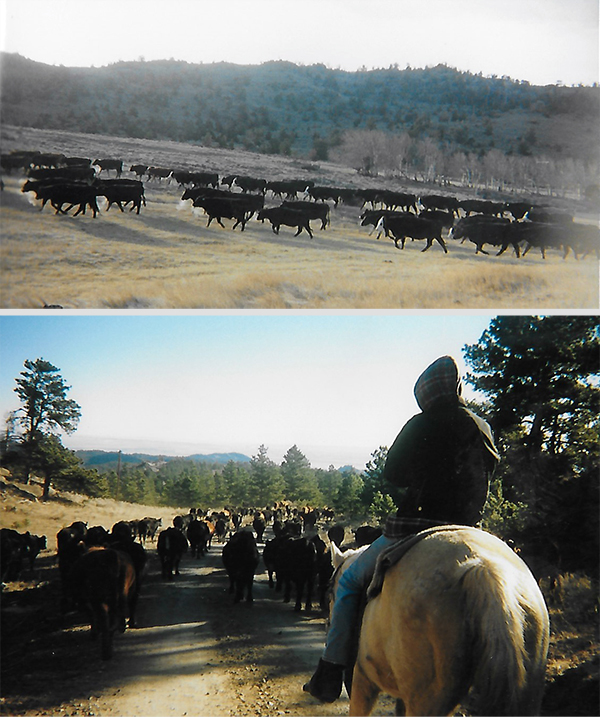
Twice a year Henry and other ranchers trail, or follow, their herd to different grazing grounds. It makes for a long day. Photos courtesy of Henry Poling.
I have come to realize that many people, when put in adverse situations, do not respond the same. I was fortunate in some unusual ways. First I did not end up being able to qualify for any disability assistance, neither SSI nor SS Disability. I really was not interested in a monthly check, as I always intended to support myself, but the medical benefits would have been useful.
One of the other big things that was extremely helpful to me were the friends and family who helped me after I got out of the hospital. They did not treat me as handicapped and insisted that I go about my daily life as much as possible. I think this, along with my own desire, helped me to adjust to my life in a chair and devise my plan to continue on the path that I had chosen in life.
If you like you can read a story about me that was in Range Magazine in the Summer of 2017. I think you can access it online. It was written by a very good friend of mine, Ray Hunkins, an attorney and two-time candidate for governor of Wyoming. He is retired now, but a truly remarkable man in his own right.
TG: Henry, wow! One hundred head of cows are a lot to take care of. I read Ray Hunkins’ story of your remarkable journey scooting on your butt for miles across rangeland after high-centering your 4-wheeler. Did you come out of that ordeal without skin damage or a pressure sore?
HP: I didn’t end up with any major sores from my crawl home but have had several over the years. Had a bone infection that required surgery from rolling a 4-wheeler, have had a lot of 4-wheeler wrecks over the years. Last wreck I had was in 2014 trailing cows to the mountains for summer. I lost my temper cutting a yearling heifer of the neighbor’s out of the herd and flipped my 4-wheeler on the pavement, landed on my head luckily, road-rashed my hand and cracked my pelvis.
A friend that was helping trail wanted to take me to the emergency room, but we had nine more miles to go up over the mountains and I told him it was OK to leave me dying by the side of the road, as when we start out with cattle somewhere, we don’t stop to go to the doctor. So I had them set my 4-wheeler on its feet and put me back on, I stuffed some paper towel in my hat to slow the blood from running down my head, and we went on. I made it the rest of the day, but the adrenaline was wearing off on the ride home in the back seat of the pickup, and I got packed to the house. Laid on the bed for a while and then got help to get in the shower to wash some of the blood off.
The next day I was going to finish taking the cows the rest of the way to the pasture where they were to go but got overruled and ended up staying home. Had a friend do chores for a couple of days as I was moving pretty slow, but I was back milking and doing chores in two days.
TG: How many acres do you own, and how many acres do you run your herd on, either owned or leased? Your talking of drought makes me think that the pastures are not irrigated.
And I’m wondering how you market your cattle. Sell them as calves or pairs, feed them up to weaning or yearling size and ship them off to auction? Do buyers come to the ranch? I assume you make more on the cattle than on selling pies and jellies and eggs or whatever you can sell in Wheatland (I saw a video of you talking about that). Just curious, but are you still paying on your property or do you own it outright?
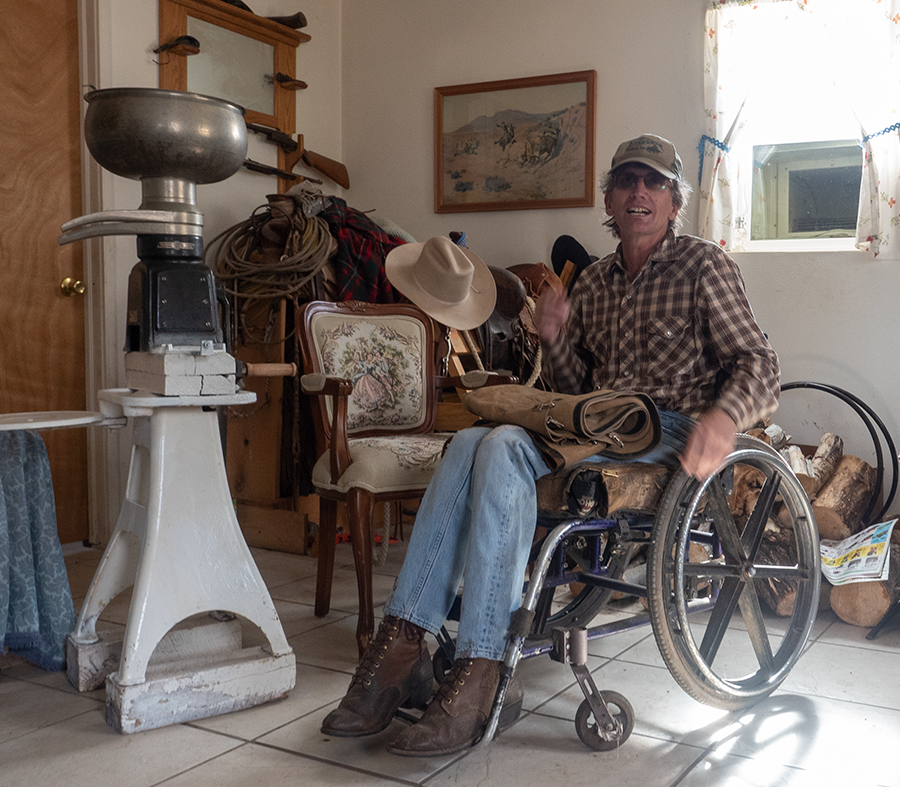 HP: My home place is 1,200 acres, which is fairly small for here. I bought it after I got hurt and still struggle along making the payments on it annually. Not too many years left to go though. I have a typical cow/calf operation where I maintain a cow herd and sell my calves in the fall, usually on Labor Day, at the local sale barn about 60 miles away. I usually sell all my calves at one sale, but sometimes I hold some younger ones back for a month or two and sell them later. This past fall, I pre-conditioned the late calves that I held back with vaccines for diseases as well as with a pour-on for parasites. This usually helps them to bring a little better price at the sale. My cow herd is mostly Angus based. They tend to bring a better price and are a lot hardier in this climate.
HP: My home place is 1,200 acres, which is fairly small for here. I bought it after I got hurt and still struggle along making the payments on it annually. Not too many years left to go though. I have a typical cow/calf operation where I maintain a cow herd and sell my calves in the fall, usually on Labor Day, at the local sale barn about 60 miles away. I usually sell all my calves at one sale, but sometimes I hold some younger ones back for a month or two and sell them later. This past fall, I pre-conditioned the late calves that I held back with vaccines for diseases as well as with a pour-on for parasites. This usually helps them to bring a little better price at the sale. My cow herd is mostly Angus based. They tend to bring a better price and are a lot hardier in this climate.
My cows graze on non-irrigated pasture, short grass prairie — excellent weight gains, but it takes quite a bit of land. I use the home place primarily to winter on and normally go to the mountains to summer the cows. I usually trail them back and forth, and for the last few years had a ranch leased from Ray Hunkins. It is normally a long day trailing up in the spring and a day trailing back in the fall.
For many years I had another place in the mountains about 55 miles from here, or 45 miles cross-country. I would truck the cows and calves up there at the end of May — 130 miles as they couldn’t cut through the mountains on the road like we could with a pickup — and had to go around by the highway to Rock River, and from there 50 miles of dirt road across the Laramie Plains. In the fall we would trail them back home using horses and 4-wheelers, covering 45 miles in three days.
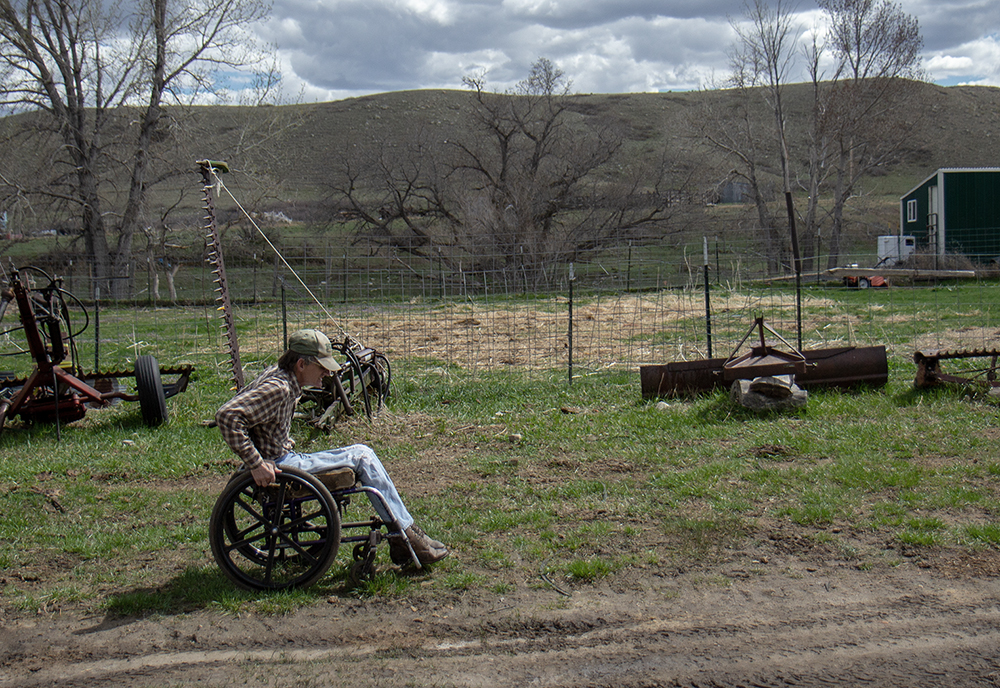 The bulk of my income comes from my cattle. I started doing jams and jellies and stuff in 2002 to make extra income due to drought and having to cut my herd from around 150 down to about 85. The sideline income has helped me to pay most of my living expenses and put cattle income into the ranch.
The bulk of my income comes from my cattle. I started doing jams and jellies and stuff in 2002 to make extra income due to drought and having to cut my herd from around 150 down to about 85. The sideline income has helped me to pay most of my living expenses and put cattle income into the ranch.
During the 2000s we had drought about every other year, so it was hard just to maintain the herd, but I did have it back up to almost 150 again by 2011, just in time for another big sell off, cutting it again in half for the drought in 2012-13. Since then it has been a struggle to grow numbers again but am finally back up over 100 mother cows and slowly working back up to a goal of 150.
TG: It sounds like a demanding life, dealing with harsh winters and drought and moving cattle long distances. What are your living conditions like?
HP: My home place sits at the base of the mountains. The previous owners had put an old trailer house on it and that was it. It had no corrals, sheds or anything, just an old trailer house. I was already in a chair of course, had never lived in a trailer, looked at the one here and thought, “Do I fix it up or burn it down?” Well I fixed it up, moved in, and in the meantime built corrals, calving shed, storage shed/shop, chicken coop and a milking barn. I cleaned ditches, picked rocks and sticks off the meadows, worked to improve them. I had help from friends and family, too.
I had to buy equipment to hay with. The first few years I traded work with a good friend for use of his equipment to put up my hay and every year I tried to add another piece or two until I had what I needed to do it on my own. Of course none of it was new, quite the opposite.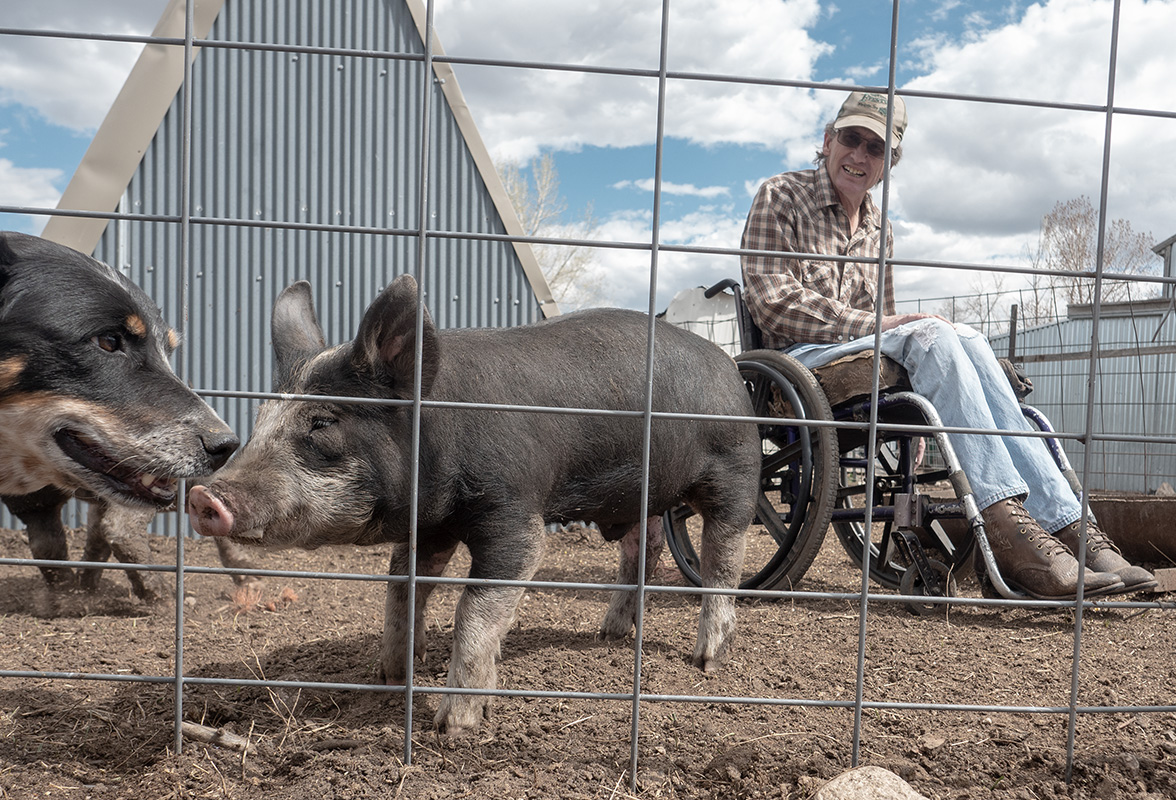 In 2008, I built my new house, after 10 ½ years in the trailer that was literally falling apart from the wind. I designed it, acted as general contractor — a pole barn building, but with 2-foot eaves. I did go with metal siding and roof because of the wind and threat of fire in summer and the fact I do not live close to a fire station. The building is 6-by-6-feet posts set 4 foot in the ground in concrete. My walls are 8 inches thick, stuffed full of insulation. Attic has 18 inches of blown-in insulation — warm in the winter and cool in the summer.
In 2008, I built my new house, after 10 ½ years in the trailer that was literally falling apart from the wind. I designed it, acted as general contractor — a pole barn building, but with 2-foot eaves. I did go with metal siding and roof because of the wind and threat of fire in summer and the fact I do not live close to a fire station. The building is 6-by-6-feet posts set 4 foot in the ground in concrete. My walls are 8 inches thick, stuffed full of insulation. Attic has 18 inches of blown-in insulation — warm in the winter and cool in the summer.
A pole barn/house has no load bearing internal walls, so I could lay it out any way I wanted. It is small by today’s standards, 1,680 square feet, but is more than adequate for me. I would not have built a house this big except that my mom was living with me for a while as she went through cancer surgery and treatments, so I needed more space. It has three bedrooms, two baths with an office, a huge kitchen with a breakfast nook and a nice-sized living/dining room.
I heat totally with wood cut from along my creek. I designed the house to keep all of the water on the east end of it and can shut French doors between the kitchen and dining area to shut off the west end of the house in the winter so I don’t have to heat it if I don’t want to. The east end of the house has the bathrooms, my master bedroom and kitchen and breakfast nook. There are no halls. Being in a chair you can appreciate how much easier that makes life. Doors are all 36 inches wide. I spent all that time in the trailer house learning all of the things I did not want in a house! It amazed me how much easier my life became after I moved in here.
.
TG: I can’t imagine living in a trailer for that long. Glad you made it into Henry’s Hilton. Must have been quite a construction project, not to mention all the other improvements you made.
I also heat with wood and love it. For decades I had a Mexican worker who came to Oregon and lived in a small trailer on my property from April to November, then went back to Vera Cruz and his family and returned again the next year. 2018 was the first year José did not return, after 30 years of loyalty. He is now 67. He would cut wood down by the creek, drag it in sections to higher ground with a tractor, then to the flat land where my 1913 two-story farmhouse is. There is also an 1880s barn built from hand-hewn timber, Douglas fir, that blew down in a huge storm around 1880.
A friend and I converted an old pig barn into a greenhouse with roll-under benches, where I started all my seedlings before planting them out. As for the wood, I did a little chain saw work but not that much. I did hand-split a lot of wood, but later went to a hydraulic splitter and José did most of the work.
Did you handle cutting and hauling and splitting and stacking all that wood by yourself?
.
HP: Good Morning, Tim. Chilly morning here, 7 degrees when I got up. We had a small covering of snow, about an inch is all.
I normally have some help with getting wood. One winter I got all of my wood alone. I dragged smaller downed trees to the house and cut them with my electric chainsaw, then stacked them. I have a hydraulic log splitter for the tractor that we split a lot of wood with and also have a three-point buzzsaw that I cut anything under 6 inches diameter with. I love the buzzsaw and usually am the one running it. I have someone pack small trees and limbs to me to cut.
I do reasonably well in snow. If it is a big snow I sometimes have to shovel my way around. I keep my 4-wheeler at the end of my ramp, so I don’t have to go far to get on it and go. We can have big snows, especially in the spring. Obviously it is tough to get around in a couple of feet of wet snow.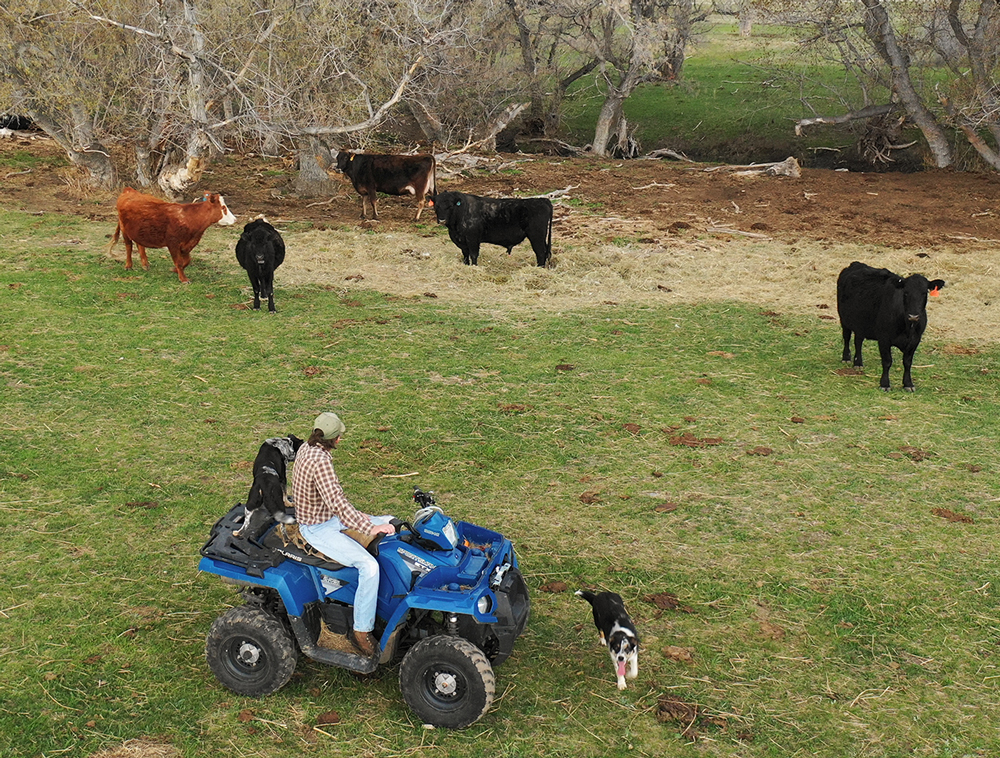 One winter I had a couple of feet of snow when I was feeding. The snow came down off the metal roof and stacked up on everything. The first day was not bad, but it started to warm and snow came sliding off my roof and piled up in front of my door where I go out to the 4-wheeler. I had forgotten to bring the scoop shovel inside so I could dig my way out, so I resorted to a stainless steel mixing bowl and dug my way to the wood on the concrete pad outside the door.
One winter I had a couple of feet of snow when I was feeding. The snow came down off the metal roof and stacked up on everything. The first day was not bad, but it started to warm and snow came sliding off my roof and piled up in front of my door where I go out to the 4-wheeler. I had forgotten to bring the scoop shovel inside so I could dig my way out, so I resorted to a stainless steel mixing bowl and dug my way to the wood on the concrete pad outside the door.
When I went to feed, I had to leave my chair in my hole outside the door that I had dug and slide on a plastic tote lid down to the 4-wheeler. Then took it up to the stackyard to open the gate, then came back down and parked next to my 8N Ford tractor and crawled over onto it to go feed. When I got done feeding, I went in reverse of the earlier steps, crawled onto the 4-wheeler, went up and closed the stackyard and came back and crawled with my tote lid back up the drift to my chair so I could come in. It was not too bad. Often times if things get too bad for too long with weather, I have neighbors and friends who will help out.
TG: Henry, it seems like you are on your own for much of the time. I’m wondering what effect being around cows and other animals for so much of your life has had on your personality, disposition and way of thinking over the years. It seems to me that we humans have much to learn from them.
HP: Good Morning Tim, I apologize for taking so long to get back to you. We had some subzero temps and snow. We were on the edge of the incredible weather that hit Nebraska and much of the Midwest. The storm came with a mighty wind, bringing snow that piled in drifts and made it tough to get around. It did have a lot of moisture in it, which we were in desperate need of, so it was welcome. I got by with no death loss in calves, which is great. Others here were not so fortunate, and of course the tragedy felt by our fellow ag producers to the east is beyond imagining. My heart goes out to those poor farmers and ranchers and what they will continue to face in coming months and even years as they struggle on to recover financially and emotionally from this.
Often times those of us in animal agriculture are viewed as heartless, soulless money grubbers, whose only feeling for the animals we raise is the money we gain from their sale. This is not true for the most part. I live in an area that is primarily family operated farms and ranches. Yes, we do have a couple of corporate operations in the area, but mainly it is people working hard to do their best to make a living for themselves and provide a healthy source of food for other Americans. I have known first-hand the sadness and disappointment of losing calves and even grown cattle to blizzards, having to wait until the snowdrifts melt to count the dead ones. I have struggled in the cold, wind and snow to bring in half frozen calves to thaw out in the house and feed them colostrum so that they’d hopefully make it.
The first concern in my mind and many others in this industry is not the money we may lose but saving this animal that is dependent on us and unable to make it on its own.
It is interesting to note how well many calves mind their mothers. I have had cows in the past that are quite adept at hiding their calves for a few days when they are first born and they seem to be able to order that calf to lie down in a certain place, usually somewhat camouflaged and the little fellow will be perfectly still even when you are right next to him. They have a pretty good ability to communicate.
I think spending my life around livestock has taught me many things. I have learned patience, especially as I get older. The old saying, “The only way to move cattle fast is slowly,” is true. I have trailed cows to pasture and home a lot over the years. The key to trailing cattle a long ways is to rest frequently. They don’t sweat and overheat easily, so it is best to rest them for a little while every few hours.
We trailed 17 miles in one day every spring to summer pasture with cow/calf pairs, up and over the mountains to the other side. People who had trailed a lot would ask me how we could make it that far in a day with young pairs. It is because I never let the cows get tired. We trailed a few miles and rested them, on water if possible, then trailed a few more miles and rested, usually 45 minutes to an hour, but enough for them to lay down, get a drink if possible and cool off.
I have also learned compassion. Having a gentle cow take you to her calf that is in need of help, and somehow she knows you are able to assist her, is a humbling thing. Struggling to save a calf dehydrated from the scours [severe diarrhea], knowing that every few hours you have to get more electrolytes down him or he will be gone is more than just a financial consideration. It is saving a life that would not make it without the assistance from a person.
Like people, cattle have a hierarchy and it changes at times, as when an old “boss” cow is no longer able to maintain her position, a younger cow fights to gain position. They definitely have personalities and sometimes I find myself just sitting and watching them eat after I have put hay out, enjoying the contented sound of cows chewing hay, watching them mill a bit, finding the choice grasses or clovers. No concerns of the world of humans, of taxes, political wars, bills or even concerns of where the hay for tomorrow is coming from. They trust it will be there.
.
TG: Henry, thanks for sending the photo of you feeding round bales to your herd. How many round bales do you feed at a time? Also, I have always assumed that you use your 4-wheeler for moving your herd, but then I keep wondering if you are still able to ride and move animals on horseback as well.
HP: I usually feed two round bales a day (each bale weighs about 500 pounds). If the weather is bad I sometimes feed three. I have not ridden for a while, mostly due to a pressure sore, but I still do ride some. Most of the time the 4-wheeler is just faster and easier for me to get things done, but I still love to ride.
TG: Lately I’ve been thinking about the “big picture” of your story — not so much the raw details and anecdotes, but the overall effect of your story. Do you have any final thoughts you want to share?
HP: I think one of the things I have learned in my life of ranching is the forgiveness of seasons. Especially spring.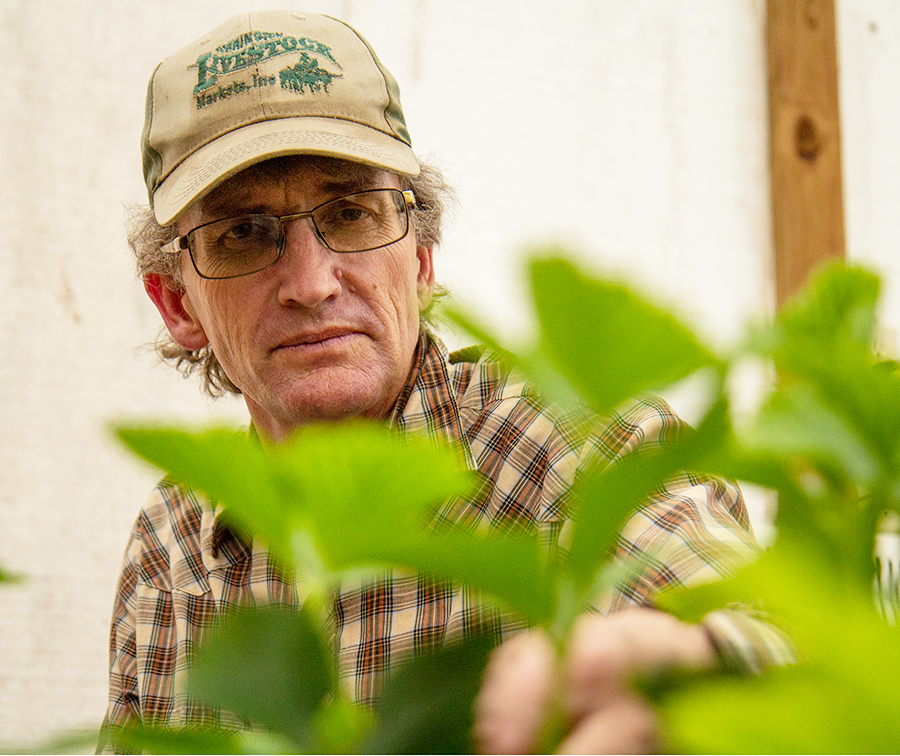 We ranchers tend to talk more about seasons in a different context — calving season, haying season, shipping, and so on. I have faced some tough calving seasons, terrible storms. But the seasons also have a way of giving back as well. A mild winter followed by a wet spring that grows grass and assures plenty of irrigating water. An abundant hay crop to get cattle through the coming winter storms.
We ranchers tend to talk more about seasons in a different context — calving season, haying season, shipping, and so on. I have faced some tough calving seasons, terrible storms. But the seasons also have a way of giving back as well. A mild winter followed by a wet spring that grows grass and assures plenty of irrigating water. An abundant hay crop to get cattle through the coming winter storms.
Calving season has always been my favorite — life renewed watching a calf just a few minutes old struggle to its feet to get its first suck. Watching the calves run and play while their mothers graze, watchful, but not dominating. Cattle have taught me a lot over the years. Enjoy a sunny day, a good meal and friendship. Yes, cattle do have friends, it is not unusual to find certain cows together a lot of the time.
I have also learned the lesson of moving on, even when tragic things happen. I have watched a cow stay by her calf for a few days after it has died, obviously saddened by the loss, but I see how they eventually go back to the herd, reintegrate and go on living. This has probably been one of the best lessons for me in dealing with life in a chair. Mourn for a bit, because the loss deserves it, then move on and make the most of the rest of your life.
Too many times significant changes tend to throw us a curve and we want to stall out and lose momentum. It is OK to do that for a little bit, regroup, but then it is time to move on. Life still has to be lived and deserves to be lived.
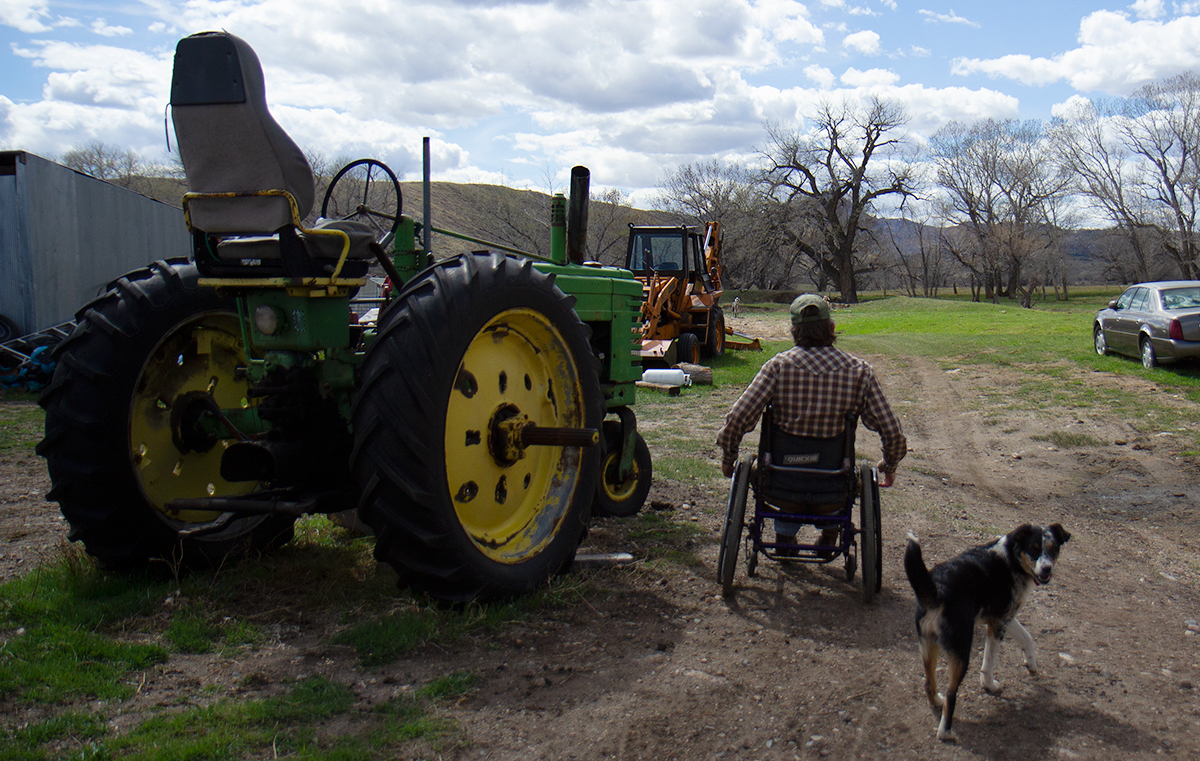
.
We are going through a bit of a rough patch in our country. Uncertain politics, leaders of our political parties focusing more on parlor games and theatrics than attending to the business of making our country safe and economically sound for its citizens. As ag producers and landowners we see our own situation somewhat threatened, often times by uninformed people with no concept of the incredible task of feeding millions of people.
It is a fairly thankless job being a food producer. Most of us in the business do it because we love what we do. We love the freedom of being self-employed, the satisfaction of growing a plant or animal that will provide life-sustaining nourishment for others. Money plays a role in it, as it does with any job, but given the hours involved in oftentimes bad weather, it is far from the primary motivation.
** This post was originally published on http://www.newmobility.com/2019/06/from-wyoming-with-love/


